GWR 5700 Class
The GWR 5700 Class, or 57xx class, is a class of 0-6-0 pannier tank steam locomotive built by the Great Western Railway (GWR) and British Railways (BR) between 1929 and 1950. With 863 built, they were the most prolific class of the GWR, and one of the most numerous classes of British steam locomotive.[2][lower-alpha 1]
| Great Western Railway 5700 class | |||||||||||||||||||||||||||||||||||||||||||||||||||||||||||||||||||||
|---|---|---|---|---|---|---|---|---|---|---|---|---|---|---|---|---|---|---|---|---|---|---|---|---|---|---|---|---|---|---|---|---|---|---|---|---|---|---|---|---|---|---|---|---|---|---|---|---|---|---|---|---|---|---|---|---|---|---|---|---|---|---|---|---|---|---|---|---|---|
 4634 at Newport High Street Station in 1954 | |||||||||||||||||||||||||||||||||||||||||||||||||||||||||||||||||||||
| |||||||||||||||||||||||||||||||||||||||||||||||||||||||||||||||||||||
| |||||||||||||||||||||||||||||||||||||||||||||||||||||||||||||||||||||
| |||||||||||||||||||||||||||||||||||||||||||||||||||||||||||||||||||||
| |||||||||||||||||||||||||||||||||||||||||||||||||||||||||||||||||||||
| |||||||||||||||||||||||||||||||||||||||||||||||||||||||||||||||||||||
Although officially designated by GWR as "light goods and shunting engines",[3] they were also used for passenger working on branch, suburban, and shorter mainline journeys.
They were distributed across most of the GWR network and, after nationalisation of the railways in 1948, across the Western Region of British Railways, and also other regions.
The 5700s were not as large as the GWR Castles and Kings, but became just as much of an icon of the GWR due to their iconic design and quantity.[4]
As a result of the 1955 Modernisation Plan, the 5700 Class was withdrawn from BR service between 1956 and 1966. Nineteen withdrawn locomotives were sold to the London Transport Executive and industry, of which ten were later preserved, along with six that were retrieved from scrapyards.
Background
The GWR started designing and building 0-6-0 tank locomotives in 1860,[5] and this continued into the BR era until 1956, with a total of 2,393 being built.[6] The GWR also used 0-6-0 tank locomotives from other manufacturers' designs (from its subsidiary and absorbed railways' stock[7]), and since 1898 it always had at least 1,000 tank locomotives in stock.[6]
The early 0-6-0 tank engines were fitted with either saddle tanks (wrapped over the boiler) or side tanks (mounted at the side of the boiler and reaching down to the running platform). GWR first fitted pannier tanks (mounted on the side of the boiler but not reaching down to the running platform) in 1898 to nine 4-4-0 tank locomotives and, in 1901, to five 0-6-0T locomotives which were also fitted with Belpaire fireboxes.[8] The shape of the Belpaire firebox gives a larger surface area which improves heat transfer and steam production,[9] but their rectangular shape made them difficult to combine with saddle tanks.[10] Locomotives fitted with pannier tanks have a lower centre of gravity than those with saddle tanks (enabling higher speeds on curves),[10] and access for maintenance is easier than for those fitted with side tanks.[11]
George Jackson Churchward's period as Chief Mechanical Engineer from 1901 to 1921 is well known for significant improvements in locomotive design and manufacture,[12] and the development of standard designs.[13] However, the scope of the standard designs did not include the 0-6-0 tank locomotive,[14] and the GWR did not introduce any new 0-6-0 tank designs from 1897 to 1928 (with exception of the 1361 Class of five 0-6-0 saddle tanks in 1910).[15]
However, pannier tanks and Belpaire fireboxes became the standard for the rebuilding of various 0-6-0 tank locomotives (projected in 1902 and getting fully underway by 1910).[6] The rebuilding program also included a number of other changes including:
- improved cab designs, eventually becoming fully enclosed[16]
- superheating, which by 1929, had been found to have little benefit on shunting engines[2]
- adaptation for working with autocoaches for push–pull trains (auto-working)[6]
- increasing boiler pressures, for example, the various rebuilds of the GWR 2721 class started at 150 lbf/in2 (1.03 MPa), increasing to 165 lbf/in2 (1.14 MPa), and then to 180 lbf/in2 (1.24 MPa)[17]
With the completion of grouping in 1923, GWR's collection of 0-6-0 tank locomotives was expanded with the stock from 28 acquired companies. The acquired tank locomotives came from different manufacturers, were a mixture of side, saddle and pannier, and varied widely by size and state of repair.[18][19] In addition, GWR's stock was wearing out,[14] and the variety of classes was problematic for maintenance and rostering.[20] Collett had to produce a new standard design for 0-6-0 pannier tanks,[3] which resulted in the 5700 Class.
Design
The first batch of 300 locomotives built between 1929 and 1931 included a medium height chimney, a mid-boiler dome, safety valve with cover, and an enclosed cab. They were similar in appearance to older 0-6-0 tank engines that had been rebuilt as pannier tanks, particularly the later rebuilds of the 2721 Class. The 2721 Class was itself a development of the 1854 Class, which in turn was based on the 645 Class.[2]
Specification
The table below gives the technical specifications of the 5700 class. Values are from GWR diagram B48[21] unless referenced otherwise.
| Dimensions |
|
|---|---|
| Firegrate area | 15.3 sq ft (1.42 m2) |
| Firebox |
|
| Tubes |
|
| Heating surface |
|
| Boiler |
|
| Working pressure | 200 lbf/in2 (1.38 MPa) |
| Cylinders |
|
| Valve gear | Stephenson (slide)[22] |
| Wheels | 4 ft 7+1⁄2 in (1.410 m) diameter, coupled |
| Wheelbase | 15 ft 6 in (7 ft 3 in + 8 ft 3 in) (4.72 m (2.21 m + 2.51 m)) |
| Tractive effort (85%) | 22,515 lbf (100.15 kN) |
| Coal capacity | 3 long tons 6 cwt (7,400 lb or 3.4 t)[2] |
| Water capacity | 1,200 imp gal (5,500 L; 1,400 US gal) |
| Weight (full) |
|
| Minimum curve |
|
The 5700s were given the GWR route colour Blue[lower-alpha 2] (based on axle load), and were in the GWR power group C (based on tractive effort).[25] The classifications were shown on the cab with the letter C in a blue disc.
le Fleming describes the 5700 class as "an almost unaltered continuation of the 27xx rebuilds"[2] and Holcroft describes them as "practically identical to 2721 rebuilds",[26] but according to Oswald Nock it was "a thoroughly modern design",[27] and Jones notes that design included "numerous detailed improvements" and reflected improved construction techniques.[28] The main differences from the 2721 class include:
- increased boiler pressure,[29] from 180 lbf/in2 (1.24 MPa)[30] to 200 lbf/in2 (1.38 MPa),[2] giving a corresponding increase in tractive effort
- improved valve settings[29]
- longer frame, from 26 ft 9 in (8.15 m)[31] to 27 ft 6 in (8.38 m)[21]
- fully enclosed cab[29]
The initial design also included a return to non-fluted coupling rods and laminated springs beneath the leading and driving axleboxes (both features harking back to the 1854 class).[2] The locomotives were also fitted with cast iron chimneys (which had only rarely been fitted to earlier locomotives),[2] and the whistles were fitted on top of the firebox rather than on top of the cab.
6700 Sub-class
Of the first batch of 300 locomotives, most were fitted with vacuum brakes and steam heating, and some of these were also fitted with GWR's Automatic Train Control (ATC) safety system.[lower-alpha 3]
However, the 50 locomotives of the 6700 or 67xx Class were not fitted with vacuum brakes, steam heating, or ATC, and were fitted with three link couplings only; they were therefore limited to shunting duties and some freight working.[32] The 6700s had a smaller minimum railway curve radius of 4 chains (260 ft; 80 m) (normal) and 3+1⁄2 chains (230 ft; 70 m) (slow) and an increased axle clearance.
8750 Sub-class
The 8750 or 87xx Class were first built in 1933, using an updated design which included an improved cab with a higher roof, rectangular windows and grills (as opposed to the round windows (or "spectacles") of the initial design), and sliding shutters and hinged doors for more protection from the elements.[24] The new style cab was derived from the sister 5400 Class, the first of which were built in 1931.[32] Vacuum brakes, steam heating, and ATC were fitted as standard (except for Nos. 6750–79, built between 1946 and 1950, which were fitted with steam brakes and three link couplings only).[24] The locomotive weight increased to 49 long tons 0 cwt (109,800 lb or 49.8 t), and the axle load increased to 17 long tons 0 cwt (38,100 lb or 17.3 t).[24]
9700 Class
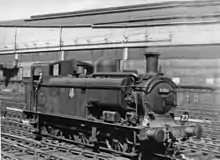
The 9700 or 97xx Class pannier tanks were a direct development of the 5700 class. The prototype for the class, No. 8700 (later No. 9700), was a rebuilt 5700 locomotive.[2] They were specifically for working on the Hammersmith & City line between Paddington station and Smithfield Meat Market. They replaced Metro and 633 class locomotives.
The eleven locomotives in the class had a condensing apparatus that fed the exhaust steam back into the water tanks.[33] The tanks themselves were shortened to make room for the external exhaust pipes and were extended down to the footplate in front of the cab to increase their capacity.[33] As condensing the steam heated the water, a reciprocating pump (Weir pump) was fitted as a boiler feedwater pump because standard injectors will not work with hot water.[33] The pumps led to (unsuccessful) tests with these locomotives acting as fire engines during World War II.
To work over the electrified underground lines, the 9700 Class locomotives had a special type of ATC equipment that lifted clear of the centre rail and had tripcock brake valves that matched the London Transport signalling system.[24][33] The design changes resulted in reduced coal (2 long tons 16 cwt (6,300 lb or 2.8 t)) capacity and a slight increase (1,230 imp gal (5,600 L; 1,480 US gal)) in water capacity.[24] The locomotive weight increased to 50 long tons 15 cwt (113,700 lb or 51.6 t), and the axle load increased to 17 long tons 4 cwt (38,500 lb or 17.5 t).[24]
Later developments
From 1936 to 1942, a number of small changes were introduced to new builds:
- In 1936, a whistle shield was added to the front of the cab to deflect steam away from the cab windows.[24]
- Also in 1936, pocket steps and extra railings were added to the fireman's side (left side) of the cab to improve access to the bunker.[24]
- In 1937, a drawing was issued for fitting shutters and doors to the older, pre-8750 class, locomotives.[24]
- In 1938, a larger whistle shield was fitted, which became standard for the larger cabs.[24]
- In 1942, a new type of top feed was introduced, with separate clackboxes in a taller cover, and internal delivery pipes rather than trays.[24]
All these changes (with the exception of the new top feed) were later applied to locomotives that had been built earlier. The new top feed became standard for new locomotives in 1944. Some older boilers and locomotives were later fitted with the new top feed, and some locomotives that were built with the new top feed were later changed back to the old design as boilers were swapped.[24]
Variants
A small number of 5700s were adapted for specific tasks:
- From 1937 to the end of World War II, thirteen 5700s were fitted with spark arresting chimneys for work on industrial and military sites with significant fire risks.[24][33][lower-alpha 4]
- In 1958, No. 3711 was converted to oil burning by Robert Stephenson and Hawthorns.[34][lower-alpha 5]
- In 1946, No. 7722 was fitted with winding gear to work the Pwllyrhebog Colliery incline on the former Taff Vale Railway.[2][34]
Production
The first 5700s were built in 1929 by North British Locomotive Co. and, later in the year, at GWR's Swindon Works.[23] Between 1929 and 1931 a total of 300 were built, of which 50 were built by GWR, and the rest by outside contractors:
- Armstrong Whitworth: 25 (Nos. 7775–99)
- W. G. Bagnall: 50 (Nos. 6700–24, 8725–49)[lower-alpha 6]
- Beyer, Peacock & Co: 25 (Nos. 8700–24)
- Kerr Stuart: 25 (Nos. 7700–24)
- North British: 100 (Nos. 5700–49, 7725–74)
- Yorkshire Engine Co: 25 (Nos. 6725–49)
It was unusual, but not unprecedented, for GWR to use outside contractors to build locomotives, as 50 of the 200 strong 5600 Class had been built by Armstrong Whitworth.[lower-alpha 7][19] The building programme was partly funded by interest-free government loans intended to relieve unemployment during the Great Depression.[2] Also, stricter accountancy rules that distinguished between maintenance and building costs meant that it was often economically worthwhile to build new locomotives rather than repair older locomotives.[37]
At first more 5700s were built than were immediately needed, so Nos. 6700–49 were stored for a couple of years before being allocated.[2] Many of these were then assigned to sheds near the South Wales ports of Newport, Barry, Cardiff and Swansea.[38]
After a gap of a year, building started again in 1933, with the 8750 and 9700 classes, and continued until 1950.[39] All the later locomotives, totalling 563, were built at Swindon, and the numbers built only dropped in the last few years with the introduction of the 9400 class in 1947.
Numbers built
A total of 863 5700s were built and the table below shows the number built by year.[2]
| Year | 1929 | 1930 | 1931 | 1932 | 1933 | 1934 | 1935 | 1936 | 1937 | 1938 | 1939 | 1940 | 1941 | 1942 | 1943 | 1944 | 1945 | 1946 | 1947 | 1948 | 1949 | 1950 |
|---|---|---|---|---|---|---|---|---|---|---|---|---|---|---|---|---|---|---|---|---|---|---|
| Numbers | 97 | 138 | 65 | 0 | 31 | 49 | 40 | 45 | 50 | 37 | 53 | 32 | 18 | 37 | 26 | 22 | 43 | 29 | 10 | 17 | 14 | 10 |
Build details
The 5700s were specified by 27 different order numbers, or lots, shown below.
| Date | Lot No. | No. Built | GWR/BR Numbers | Builder and Numbers | Notes[41] |
|---|---|---|---|---|---|
| Jan–Apr 1929 | 256 | 50 | 5700–49 | North British Locomotive Co.
23818–67[lower-roman 1] |
Built with vacuum brakes, but without steam heating apparatus or ATC (Automatic Train Control), which were both added later.
Delivered with brass number plates (as were all later locomotives built by outside contractors). |
| Apr–Sep 1929 | 258 | 30 | 5750–79 | Swindon Works, GWR | Built with vacuum brakes and steam heating. Fitted with ATC in the following few years.[lower-roman 2]
Fitted with cast iron number plates (as were all later locomotives built at Swindon). |
| Dec 1929 – Nov 1930 | 260 | 20 | 5780–99 | Swindon Works, GWR | Built with vacuum brakes and steam heating. Nos. 5790–99 were fitted with ATC. Nos. 5780–5789 were fitted with ATC in the following few years. |
| Dec 1929 – Feb 1930 | 264 | 25 | 7725–49 | North British Locomotive Co.
23921–45[lower-roman 1] |
Built with vacuum brakes and steam heating. ATC added a few years after delivery. |
| Jan–Mar 1930 | 263 | 25 | 7700–24 | Kerr Stuart
4435–59 |
Built with vacuum brakes and steam heating. ATC added a few years after delivery.
Fitted with riveted tanks[lower-roman 3] and polished brass safety valve covers. |
| Feb–Oct 1930 | 262 | 25 | 6700–24 | W. G. Bagnall
2381–2405 |
Built with steam brakes only and three link couplings.[43]
Fitted with riveted tanks.[lower-roman 3] |
| Mar 1930 – Jan 1931 | 265 | 25 | 6725–49 | Yorkshire Engine Co.
2249–73 |
Built with steam brakes only and three link couplings.
Fitted with riveted tanks.[lower-roman 3] |
| Nov 1930 – Jan 1931 | 271 | 25 | 7775–99 | Armstrong Whitworth
1131–55 |
Built with vacuum brakes and steam heating apparatus (as were all later locomotives). ATC added on arrival at Swindon (as were all later locomotives supplied by contractors).
Fitted with polished brass safety valve covers. |
| Dec 1930 – Sep 1931 | 272 | 25 | 8725–49 | W. G. Bagnall
2422–46 |
Fitted with riveted tanks[lower-roman 3] and polished brass safety valve covers. |
| Feb–Apr 1931 | 273 | 25 | 8700–24 | Beyer Peacock
6680–6704 |
Fitted with polished brass safety valve covers. Includes the first No. 8700, which was later modified as the prototype for the 9700 class, and was renumbered No. 9700 in January 1934. |
| Nov 1930 – Mar 1931 | 274 | 25 | 7750–74 | North British Locomotive Co.
24038–62[lower-roman 1] |
|
| Sep–Dec 1933 | 282 | 10 | 9701–10 | Swindon Works, GWR | Built for working on London Transport lines. Built with new style cab, condensing equipment, Weir pump, modified ATC (to lift clear of central rail), and tripcock brake valves. |
| Sep 1933 – Mar 1934 | 282 | 49 | 8750–98 | Swindon Works, GWR | Built with new style cab, ATC, steam heating, and vacuum brakes. This was the standard equipment for all later locomotives (with the exception of Nos. 6751–59 (Lot No. 362, 1947) which were for shunting only). |
| Mar 1934 | 282 | 1 | 8700 | Swindon Works, GWR | The second No. 8700. The first was modified with condensing equipment and new cab as the prototype for the 9700 class. The old cab was saved and fitted to the new No. 8700. |
| Jun 1934 | 285 | 1 | 8799 | Swindon Works, GWR | |
| Jun 1934 – Jun 1935 | 285 | 49 | 9711–59 | Swindon Works, GWR | |
| Sep 1935 – Jul 1936 | 293 | 25 | 9760–84 | Swindon Works, GWR | Whistle shields were introduced (probably first to No. 9773). |
| May 1936 – Sep 1936 | 299 | 15 | 9785–99 | Swindon Works, GWR | Pocket steps and extra handrails were added to the left of the bunker. First fitted to No. 9795. |
| Sep 1936 – Aug 1937 | 299 | 35 | 3700–34 | Swindon Works, GWR | |
| Aug 1937 – Sep 1938 | 306 | 50 | 3735–84 | Swindon Works, GWR | A larger whistle shield was introduced and first fitted to No. 3774. |
| Sep–Dec 1938 | 314 | 15 | 3785–99 | Swindon Works, GWR | |
| Dec 1938 – Jul 1939 | 314 | 35 | 3600–34 | Swindon Works, GWR | |
| Sep 1939 – Jul 1940 | 325 | 50 | 3635–84 | Swindon Works, GWR | |
| Dec 1940 – Sep 1941 | 330 | 15 | 3685–99 | Swindon Works, GWR | |
| Sep 1941 – Nov 1942 | 330 | 35 | 4600–34 | Swindon Works, GWR | |
| Dec 1942 – Jun 1943 | 336 | 26 | 4635–60 | Swindon Works, GWR | |
| Oct 1943 – Feb 1945 | 352 | 39 | 4661–99 | Swindon Works, GWR | |
| Feb–Oct 1945 | 352 | 22 | 9600–21 | Swindon Works, GWR | |
| Nov 1945 – Mar 1946 | 355 | 20 | 9622–41 | Swindon Works, GWR | |
| Apr–Jun 1946 | 356 | 10 | 9642–51 | Swindon Works, GWR | |
| Nov–Dec 1946 | 362 | 10 | 9652–61 | Swindon Works, GWR | |
| Jun–Sep 1947 | 362 | 10 | 6750–59 | Swindon Works, GWR | Built with steam brakes only and three link couplings. |
| Apr–Jun 1948 | 370 | 11 | 9662–72 | Swindon Works, BR | |
| Nov 1948 – Jan 1949 | 374 | 10 | 6760–69 | Swindon Works, BR | Built with smokebox number plates, as were all later locomotives. |
| Feb–May 1949 | 378 | 10 | 9673–82 | Swindon Works, BR | |
| Nov–Dec 1950 | 379 | 10 | 6770–79 | Swindon Works, BR |
- Nos. 5700–24 were built at Hyde Park. All other locomotives from North British Locomotive Co. were built at Queens Park.[39]
- Ten locomotives (Nos. 5768 and 5770–78) were fitted with boilers where the steam supply to the fountain in the cab was taken in a covered pipe along the tank top from the dome. This feature was later discontinued and the boilers replaced.[2]
- Welding had been standard for GWR panniers for some time.[42] However, the panniers supplied by Bagnall, Kerr Stuart, and Yorkshire Engine were riveted.
Costs
Some known costs (either GWR's out-shop value or cost from contractors) are shown below, along with estimated equivalent values for 2013.
| GWR No. | Builder | Date | Cost | 2013 labour cost[lower-roman 1] | 2013 economic cost[lower-roman 2] |
|---|---|---|---|---|---|
| 5764 | Swindon Works, GWR | Jun 1929 | £2,651[lower-roman 3][47] | £419,500 | £894,900 |
| 7714 | Kerr Stuart[lower-roman 4] | Apr 1930 | £1,160[49] | £185,000 | £398,100 |
| 7754 | North British Locomotive Co. | Dec 1930 | £2,800[50] | £446,500 | £961,000 |
| 3650 | Swindon Works, GWR | Dec 1939 | £2,844[51] | £414,100 | £761,200 |
| 4612 | Swindon Works, GWR | Feb 1942 | £3,451[52] | £425,000 | £576,500 |
| 9682 | Swindon Works, BR | May 1949 | £5,280[53] | £429,900 | £657,200 |
- Relative value calculated using a wage index.[44] Specific values calculated here.[45]
- Relative value calculated as a proportion of the total output of the economy.[44] Specific values calculated here.[45]
- For comparison GWR Hall class No. 4953 Pitchford Hall, also built at Swindon in 1929, cost £4,375.[46]
- The 5700s built by Kerr Stuart were amongst the last built by the company.[48] See Kerr Stuart in liquidation for details.
Numbering and liveries
The size of the class demanded that the 5700 class locomotives were spread across several series of numbers.[32]
- 3600 – 3699
- 3700 – 3799
- 4600 – 4699
- 5700 – 5799
- 6700 – 6779
- 7700 – 7799
- 8700 – 8799
- 9600 – 9682
- 9700 – 9799
The different series started in the following chronological order; 57xx (1929), 77xx (1929), 67xx (1930), 87xx (1931), 97xx (1933), 37xx (1936), 36xx (1938), 46xx (1941), and 96xx (1945).[54] GWR locomotives were not renumbered after nationalisation, but a W (for Western Region) was temporarily added to some locomotives.
The first 5700s built were painted in the standard GWR livery of the time; mainly green above the running plate with the words "GREAT WESTERN" painted in yellow letters with red and black shadowing on the side of the pannier tanks, buffer beams painted red with the number shown in yellow letters with black shadowing, and the front of the smokebox and chimney were black.[55] From 1934 the GWR "shirtbutton" roundel replaced "GREAT WESTERN".[56] From 1942 GWR replaced the roundel with the letters "G W R", in yellow letters with red and black shading.[57] Due to wartime shortages, most locomotives (apart from the Kings and Castles) were painted black from 1942 to 1945.[58]
After nationalisation, some 5700s were painted in BR green with the words "BRITISH RAILWAYS" on the side of the pannier tanks,[59] but unlined black soon became the standard for tank locomotives, with the BR crest on the sides of the pannier tanks. Some 5700s also had white and red lining on the pannier tanks and cab sides. The BR crest was changed in 1957.[60]
The 5700s bought by London Transport between 1956 and 1963 were repainted in the standard LT maroon livery with yellow and black lining.[61] Those bought by NCB were painted in a light green.[50]
Operation
The 5700s were used on GWR for various duties including shunting, pilot work, and light to medium goods. They were also used on branch, commuter and shorter mainline passenger trains.[62][4] They were also used on standby for more powerful locomotives, sometimes producing "firework displays" as they strived to keep to the schedule with heavier loads.[24]
The 5700s were never fitted remote control gear for working autotrains. This was left to smaller pannier locomotives that followed; the 5400 Class (introduced in 1930) and the 6400 Class (introduced in 1932).[63]
The 9700s (fitted with condensing equipment for underground working) and built specifically for working the line between Paddington and Smithfield, were allocated to Old Oak Common.[25]
The 6700s (built for shunting only and kept in storage for a couple of years because of a lack of suitable work) eventually found their niche working the marshalling yards between the South Wales coalfields and the coal exporting docks of Llanelli, Swansea, Cardiff, Barry and Newport. Some were allocated to just one shed for their entire working life (Nos. 6700–9 at Cardiff East Dock and Nos. 6725–32 at Newport, Pill). A number of 6700s were also allocated to Swindon, with 6733–41 spending a long time there.[25]
Thirteen 5700s were fitted with spark arresting chimneys for working in industrial and military systems and sidings, particularly the War Department ammunition dump at Milton, near Didcot during World War II.[64]
The Pwllyrhebog Colliery incline on the former Taff Vale Railway[2] was a 3⁄4 mile (1.2 km) 1-in-13 incline with a continuous rope cable so that a descending train was partially counterbalanced by an ascending train. The locomotives (Taff Vale Railway H class) on the incline were fitted with coned boilers so that there was always sufficient water above the firebox. To provide additional control and power a stationary locomotive, fitted with two intergeared drums, controlled the cable.[34] No. 2750 Class 2721 had been fitted with the necessary winding gear to control the incline in 1935,[30] but was withdrawn in 1945,[65] and replaced by 5700 No. 7722 which was fitted with the winding gear in 1946.[24] Operation of the incline ended in 1952.[34]
Allocation
The 5700s' route classification (Blue) meant that they were allowed on approximately 70% of the GWR network. By 1938 only 15[lower-alpha 8] (out of approximately 70) running sheds did not have any 5700s allocated.
In 1950, the route classification was changed to Yellow because of the 5700s' low hammer blow.[24] The change did not apply to Nos. 9700–10. This meant that 5700s were now allowed on almost 90% of the old GWR network (roughly equivalent to the new Western Region of British Rail). By 1954, only five running sheds (Abercynon, Aberystwyth, Machynlleth, Treherbert and Truro) did not have any 5700s allocated.[24]
BR working
In the early years of British Railways, the boundaries between the Western and the Southern Region changed a number of times.[66] 5700s took up new duties in a variety of places:
- At Weymouth, 5700s operated the branch line to the Isle of Portland (replacing LSWR O2 class 0-4-4T locomotives).[66] They were also seen pulling boat trains through the streets of Weymouth.
- Six 5700s were allocated to Nine Elms and worked empty stock between Waterloo and Clapham Junction (replacing LSWR M7 class 0-4-4T locomotives).[66]
- The short Folkestone Harbour branch line from Folkestone Harbour station to Folkestone Junction was always problematic when hauling heavy boat trains up the 1-in-36 incline.[67] Six 5700s were allocated to Dover for working (including banking) on the branch (replacing SER R1 class 0-6-0T locomotives).[68]
The last scheduled passenger trains hauled by 5700s on BR were on seen London Midland Region on the Wrexham to New Brighton route (passing over old LNER territory). The Wrexham to Seacombe service ended at the beginning of 1960 but was immediately replaced by a DMU service between Wrexham and New Brighton. The service on Bank Holidays was so popular that demand outstripped available DMUs, and a relief train of four coaches pulled by No. 3749 was laid on. Two more 5700s were used over the Spring Bank Holiday that year, but from then BR Standard Class 4 2-6-4T locomotives usually handled the relief services. In 1965, 5700s were used for the last time on Whit Monday and August Bank Holiday relief services.[69]
The 5700s were the last steam locomotives used on Western Region. The last working locomotives were allocated to Croes Newydd, and were working goods trains and shunting until November 1966.[70][lower-alpha 9] By the end of the steam era, the record keeping of allocations and working of local steam locomotives was rather lax, and it was not unknown for locomotives to be used after being officially withdrawn. For many years Nos. 4646, 4696, and 9774 were thought to be the last ex-GWR locomotives to work on British Rail, but No. 9641 was also still in steam at Croes Newydd at the same time.[72]
5700s at work
 No. 3620 with a typical goods train at Southall station
No. 3620 with a typical goods train at Southall station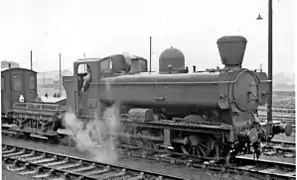 No. 4601 with spark arresting chimney for shunting at the WD sidings at Milton
No. 4601 with spark arresting chimney for shunting at the WD sidings at Milton.jpg.webp) A boat train on the quayside at Weymouth with No. 4624
A boat train on the quayside at Weymouth with No. 4624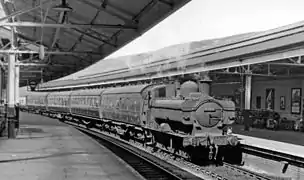 No. 9792 hauling empty stock at Swansea High Street station
No. 9792 hauling empty stock at Swansea High Street station No. 9662 on pilot duty at Newport High Street station
No. 9662 on pilot duty at Newport High Street station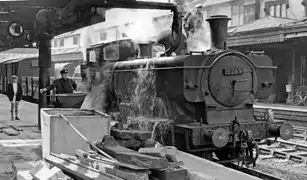 No. 3769 taking on water at Shrewsbury station
No. 3769 taking on water at Shrewsbury station No. 9791 racing Castle Class No. 7006 Lydford Castle at Southall
No. 9791 racing Castle Class No. 7006 Lydford Castle at Southall Llanelly depot - Nos. 7211 (7200 class), 1633 (1600 class), 3642 (5700 class), 1607 (1600 class) and 5722 (5700 class)
Llanelly depot - Nos. 7211 (7200 class), 1633 (1600 class), 3642 (5700 class), 1607 (1600 class) and 5722 (5700 class)
Accidents and incidents
- On 26 August 1940, a bombing raid destroyed a goods shed at Bordesley, West Midlands. During the raid Peter Smout, an 18-year-old engine cleaner who was acting as the fireman on a shunter, volunteered to drive No. 7758 to pull wagons out of the blazing goods shed. He made three more trips. He was assisted by Frederick Blake, a wagon examiner and a navy veteran from World War I, who operated the points levers. When they finished, the right hand side of the footplate was too hot to touch, and Blake had to use his hat to work the points as the levers were also too hot to touch. Both men were awarded the George Medal for their courage.[73][74][lower-alpha 10]
- On 7 December 1961, a locomotive of the class was in collision with a freight train at Bodmin General station, Cornwall due to a faulty signal failing to give a clear danger aspect.[76]
Other pannier tank locomotives
There were numerous other classes of pannier tanks built by the GWR. The majority belonged to two "families" of "large" and "small" designs. Others included absorbed stock, more specialised types and conversions of tender locos. The two main groups were:
- A "large" group originally featuring saddle tanks (or in a few cases side tanks), 4 ft 6 in driving wheels and double frames e.g. 1076 Class or inside frames GWR 645 Class, culminating in the 9400 Class.
- A "small" group originally built at Wolverhampton Works with saddle tanks and driving wheels of 4 ft commencing with the GWR 850 Class and culminating in the 1600 Class
For example, within the "small" group, the GWR 5400 Class locomotives were derived from the William Dean-designed GWR 2021 Class (an enlargement of the 850 Class), with larger wheels for higher top speed and fitted with autotrain apparatus ('auto-fitted') for push-pull passenger work. The GWR 6400 Class were similar to the 5400 Class, also being auto-fitted, but having the same size wheels as the 5700. The GWR 7400 Class were very similar to the 6400 Class, but were not auto-fitted and had a higher boiler pressure.
Within the "large" group, the GWR 9400 Class was the post-war updated design of the 8750 variant of the 57xx: heavier and longer, but nominally no more powerful, using the same taper boiler as the GWR 2251 Class.
For a list of classes, see GWR 0-6-0PT.
Withdrawal and mileages
After the 1955 Modernisation Plan, the reduction in branch line work and the introduction of diesel shunters, the Western Region embarked on a dieselisation programme which, along with a reduction in branch line work, reduced the demand for the services of the 5700s.[77] Withdrawal from service with BR started in 1956 and was completed in 1966.[54]
Twenty locomotives[78] were sold and continued in use until 1971 by the London Transport and 1975 by the National Coal Board.
| Year | 1956 | 1957 | 1958 | 1959 | 1960 | 1961 | 1962 | 1963 | 1964 | 1965 | 1966 |
|---|---|---|---|---|---|---|---|---|---|---|---|
| Numbers[54] | 4 | 16 | 48 | 67 | 67 | 67 | 170 | 114 | 144 | 139 | 27 |
le Fleming noted that the mileages of those withdrawn between March 1956 and March 1958 ranged "between 500,000 and 556,000".[25] Some other known mileages are shown below.
| Number | Built | Withdrawn | Mileage |
|---|---|---|---|
| 3650[79] | Dec 1939 | Sep 1963 | 493,100 mi (793,600 km) |
| 3738 [80] | Sep 1937 | Jul 1963 | 500,000 mi (800,000 km) |
| 4612 [52] | Feb 1942 | Jul 1965 | 427,707 mi (688,328 km) |
| 5764 [47] | Jun 1929 | (Dec 1963)[lower-roman 1] | 668,771 mi (1,076,283 km) |
| 7714 [81] | Apr 1930 | Jan 1959 | 520,259 mi (837,276 km) |
| 9629 [82] | Dec 1945 | (Sep 1961)[lower-roman 2] | 385,188 mi (619,900 km) |
| 9682 [53] | May 1949 | Aug 1965 | over 250,000 mi (400,000 km) |
- withdrawn from BR May 1960. Mileage from later LT records.
- Date of last Heavy General Overhaul (H/G). Withdrawn Oct 1964.
Use after British Railways
Nineteen 5700s were sold for further use after being withdrawn by British Railways. The National Coal Board (NCB) bought five, one was bought by P.D. Fuels, and thirteen were bought by London Transport.[83]
One more locomotive, No. 9642, was withdrawn in 1964 and sold to Hayes Scrapyard. It was used for three years to shunt other locomotives being scrapped, and was later saved for preservation.[84]
London Transport
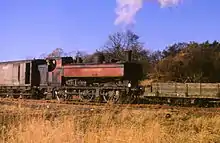
Although the London Underground network had been electrified for many years (the then Metropolitan Railway was electrified in 1905) a small number of steam locomotives were retained for engineering and ballast trains.[85] By the 1950s, the locomotives were past their prime and expensive to maintain, and the planned quadrupling of part of the Metropolitan line would require reliable locomotives.[86] London Transport considered replacing the steam fleet with diesel shunters, and had also tested (unsuccessfully) a Great Northern Railway Class J52 locomotive in 1955.[87]
The first 5700 locomotive, No. 7711, underwent trials from January to April 1956, first running between Finchley Road and Baker Street. Modifications were needed to the cab for clearance and the tripcock brake valves after problems were found when running in reverse. Curtains were also fitted to the cab to reduce smoke and fumes in tunnels. In May, the 5700s became the standard for engineering trains on London Transport when they bought No. 7711 (for £3,160), decided to buy another (No. 5752), and planned to buy more over the coming years.[88]
Thirteen 5700s were bought by London Transport (from 1956 to 1963).[83] They were numbered L89 to L99 and were allocated to the depots at Lillie Bridge (Fulham) and Neasden.[89] Only eleven were running at any one time, the original L90 and L91 were withdrawn for repairs but scrapped instead and replaced by other locomotives which carried the same number.[90]
They worked permanent way trains and were never used on normal passenger services. Main line running included trips between depots, to Acton Works and runs out to Croxley Tip, near Watford.[91]
Three of the LT 5700s lasted until the end of steam on London Transport in 1971 and were the last steam locomotives used for regular mainline working in the UK.[92][lower-alpha 11] London Transport commemorated the end of operating steam locomotives with a special run from Moorgate station to Neasden depot. The train comprised No. L94 (No. 7752) and a selection of maintenance rolling stock.[93] Three diesel-hydraulic locomotives were bought to carry out the shunting duties from then on.[90]
| LT Number | BR No. | Date Built | Date to LT | Withdrawn by LT | Notes |
|---|---|---|---|---|---|
| L89 | 5775 | 1929 | 1963 | 1969 | Sold to Keighley & Worth Valley Railway[lower-alpha 12] |
| L90 (I) | 7711 | 1930 | 1956 | 1961 | Scrapped |
| L90 (II) | 7760 | 1930 | 1961 | 1971 | Sold to 7029 Clun Castle Ltd[lower-alpha 13] |
| L91 (I) | 5752 | 1929 | 1956 | 1960 | Scrapped |
| L91 (II) | 5757 | 1929 | 1960 | 1968 | Scrapped |
| L92 | 5786 | 1930 | 1958 | 1969 | Sold to Worcester Locomotive Society[lower-alpha 14] |
| L93 | 7779 | 1930 | 1958 | 1968 | Scrapped |
| L94 | 7752 | 1930 | 1959 | 1971 | Sold to 7029 Clun Castle Ltd[lower-alpha 13] |
| L95 | 5764 | 1929 | 1960 | 1971 | Sold to Severn Valley Railway[lower-alpha 15] |
| L96 | 7741 | 1930 | 1961 | 1967 | Scrapped |
| L97 | 7749 | 1930 | 1962 | 1970 | Scrapped |
| L98 | 7739 | 1929 | 1962 | 1970 | Scrapped |
| L99 | 7715 | 1930 | 1963 | 1969 | Sold to Quainton Railway Society[lower-alpha 16] |
National Coal Board

Between 1959 and 1965, the National Coal Board (NCB) bought five 5700s from BR for use at pits in South Wales, continuing a tradition of the GWR selling withdrawn pannier tank locomotives to the NCB.[83] The engines retained their BR numbers. The NCB locomotives did not receive maintenance to match GWR standards and were run into the ground, saving the cost of expensive overhauls.[68]
One of the NCB 5700s, No. 7754, was the last in industrial service, and after working at various collieries was moved to Deep Duffryn Colliery at Mountain Ash in 1970, where an ex-GWR fitter kept it working until 1975 when a loose piston resulted in a blown cylinder cover. No. 7754 could still be seen on shed in 1980.[98] The NCB donated No. 7754 to the National Museum Wales, who placed it on permanent loan to the Llangollen Railway. It is now owned by the Llangollen Railway Trust.[98]
| BR No. | Date Built | Date to NCB | Location | Notes |
|---|---|---|---|---|
| 3663 | 1940 | 1962 | Nine Mile Point | Scrapped 1966[99] |
| 7714 | 1930 | 1959 | Penallta | Sold to Severn Valley Railway[lower-alpha 15] |
| 7754 | 1930 | 1959 | Mountain Ash | Donated by NCB to the National Museum Wales |
| 9600 | 1945 | 1965 | Merthyr Vale | Sold to 7029 Clun Castle Ltd[lower-alpha 13] |
| 9792 | 1936 | 1964 | Maerdy | Scrapped 1973[99] |
Other uses
.jpg.webp)
No. 3650 was withdrawn in 1963 and then sold to P.D. Fuels, a division of Stephenson Clarke Ltd., and was used to move spoil to slag heaps at Gwaun-Cae-Gurwen colliery near Ammanford, Carmarthenshire.[79] It was later bought and restored by members of the Great Western Society and became operational in 2009.
No. 9642 was withdrawn in 1964 and sent to Hayes Scrapyard, near Bridgend. Rather than being scrapped, it was used to shunt other locomotives being scrapped. It was due for disposal in 1967, making it the 346th locomotive to be scrapped there, but due to a last minute intervention[100] the locomotive was bought in 1968 and restored by the South Wales Pannier Group, becoming the first member of the class to be preserved.[101] It was moved to Maesteg Colliery, where it gave brake van rides from the late 1960s and throughout the 1970s.[102][103]
Preservation
Sixteen 5700 class locomotives have been preserved of which one half are from the original 5700 Class and the other half are members of the 8750 sub-class. 11 are Swindon built classmembers with the remaining five being from outside contractors. Of the sixteen engines, five are currently operational. Four of the class have worked mainline trains: 7715, 7752, 7760 and 9600. As of 2020, none of the engines are mainline certified: 7715, 7752, 7760 and 9600 are stored out of service awaiting overhauls. Two locomotives are on static display, and two are in store. Six locomotives are undergoing, or waiting for, maintenance. One locomotive, No. 9629, is being restored, and has not been in steam since it was sent to Barry Scrapyard in 1965.
A number of those bought from London Transport, which had been maintained by British Railways, were still in running order and were used on heritage railways with minimal work. No. 5764 (LT L95) was steamed the day it arrived at Bridgnorth on the Severn Valley Railway, being lit-up before it had been removed from the low-loader on which it was delivered.[47] As of June 2018, Nos. 7752 (LT L94) and 5786 (LT L92) can be seen running in the maroon livery of London Transport, but No. 7715 (LT L99) is currently out of service.[104][105][106]
The locomotives that were preserved after NCB and industrial use required rather more work than those acquired from London Transport. Some had been laid up for sometime after being withdrawn, and had received very little, if any, maintenance.[107]
Of the twelve 5700s that went to Barry Scrapyard, five were saved for preservation and one (No. 3612) was bought for spares by the Severn Valley Railway.[108]
| No. | Photo | Notes | Year Built | Location Built | Operated/owned by |
|---|---|---|---|---|---|
| 3650 (8750) | .jpg.webp) |
No. 3650 was withdrawn in 1963 and bought by Stephenson Clarke to work in a South Wales colliery. It was later bought by a Great Western Society (GWS) member[lower-alpha 17] and moved to Hereford. It was then moved to Didcot Railway Centre around 1970 for full restoration and was restored to service in 2008.[43] It was withdrawn in 2016 for overhaul which is in progress.[110] | 1939 | Swindon Works | Didcot Railway Centre |
| 3738 (8750) | .jpg.webp) |
No. 3738 was withdrawn in 1965 and sent to Barry Scrapyard. It was bought by two GWS members and taken to Didcot Railway Centre in 1974, and restored to full use in 1975.[111] After overhauls it last returned to service in 2007.[112] It was taken out of service in 2013 because of firebox problems and is on static display.[111] | 1937 | Swindon Works | Didcot Railway Centre |
| 4612 (8750) | 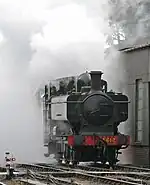 |
No. 4612 was withdrawn in 1965, sent to Barry scrapyard, and later bought by the Keighley & Worth Valley Railway (KWVR) in 1981 for spares.[52] It was then bought privately in 1987 and was restored by the Swindon Railway Workshop.[lower-alpha 18] After restoration was completed in 2001, No. 4612 was moved to the Bodmin and Wenford Railway which now owns the locomotive, and returned to service in 2013 following a ten-year overhaul.[113] | 1942 | Swindon Works | Bodmin and Wenford Railway |
| 5764/L95 (5700) | .jpg.webp) |
No. 5764 was sold to London Transport (LT) in 1960 and renumbered L95. It was sold to the Severn Valley Railway[lower-alpha 15] in 1971, and was operational less than a month after last being used on LT.[47] It was last used on New Year's Eve 2010,[114] and is currently (March 2019) on display in The Engine House in LT livery.[115] | 1929 | Swindon Works | Severn Valley Railway |
| 5775/L89 (5700) | 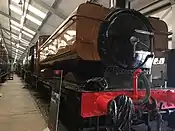 |
No. 5775 was sold to LT in 1958 and renumbered L89. It was sold to the KWVR in 1970 and soon appeared in the film The Railway Children in the brown livery of the fictional Great North & South Railway (GN&SR).[116] No. 5775 went to Locomotion, the National Railway Museum at Shildon in May 2014 to be repainted in the livery used in the film for an exhibition, and returned to the KWVR in time for a celebration of the making of the film in May 2015.[117][118][119] Currently, the loco is on display in the exhibition shed at Oxenhope station pending a further overhaul. | 1929 | Swindon Works | Keighley and Worth Valley Railway |
| 5786/L92 (5700) | .jpg.webp) |
No. 5786 was sold to LT in 1958 and renumbered L92. It was sold to the Worcester Locomotive Society in 1969 and was based at Bulmers Railway Centre until 1993.[120] Since then it has been on loan to the South Devon Railway. It returned to service in 2013 in the maroon livery of LT.[105] 5786's boiler ticket expired on the 31st May 2023, it is currently undergoing a 10-year overhaul.[121] | 1930 | Swindon Works | South Devon Railway |
| 7714 (5700) |  |
No. 7714 was withdrawn in 1959 and sold to the National Coal Board (NCB). It was bought by SVR [lower-alpha 15] in 1973 and was first steamed in 1992 after an extensive overhaul.[48] Withdrawn from service in 2009,[48] the engine re-entered service after overhaul in late November 2016. It currently wears the BR Unlined Black livery. | 1930 | Kerr Stuart | Severn Valley Railway |
| 7715/L99 (5700) |  |
No. 7715 was sold to LT in 1959 and renumbered L99. It was bought by the London Railway Preservation Society in 1968 and was later certified for mainline operation on British Rail.[48] No. 7715 has worked specials on LT and has been loaned to other heritage railways and operators, but was withdrawn from service because of a cracked boiler foundation ring. It returned to Quainton[lower-alpha 19] in May 2014 and is awaiting the necessary repairs to return it to service.[106] | 1930 | Kerr Stuart | Buckinghamshire Railway Centre |
| 7752/L94 (5700) | .jpg.webp) |
No. 7752 was sold to LT in 1959 and renumbered L94. In 1971 No. 7752 hauled the last steam train on the London Underground. It was immediately bought by 7029 Clun Castle Ltd., and is certified for mainline operation.[122] It has visited various heritage railways and was outshopped in LT livery in 2011 to celebrate the fortieth anniversary of the last run on London Underground.,[104] Locomotive is to be repainted back to GWR Green with 'GREAT WESTERN' lettering at Minehead during loan to the WSR for the 2019 season | 1930 | NBL Glasgow | Vintage Trains, Tyseley[lower-alpha 13] |
| 7754 (5700) | 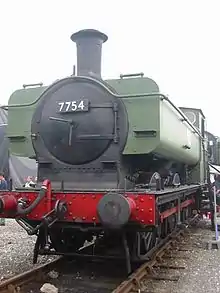 |
No. 7754 was withdrawn in 1959 and sold to National Coal Board (NCB) and worked at various collieries until 1975, becoming the last 5700 in "real", rather than "heritage", service.[123] The NCB were persuaded to donate the locomotive to National Museum Wales who loaned it to Llangollen Railway, which now owns the locomotive. After a long and expensive overhaul, and the addition of parts from No. 3612 which was held for spares by the SVR, it moved under its own power in 1993.[124] After many years in service No. 7754 is currently out of traffic undergoing overhaul.[125]
Following completion of an extensive overhaul in Llangollen engine shed, 7754 returned to service in September 2023 wearing Transitional livery (Great Western Green with British Railways lettering in GWR Egyptian font).[126] |
1930 | NBL Glasgow | Llangollen Railway |
| 7760/L90 (5700) | 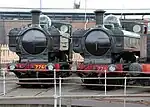 |
No. 7760 was sold to LT in 1961, renumbered L90 (replacing No. 7711 which was scrapped), and then sold to 7029 Clun Castle Ltd in 1971 in full working order. It has been loaned to various heritage railways and was certified for mainline operation in 2000.[127] As of 2014 No. 7760 is out of service and awaiting overhaul.[128] | 1930 | NBL Glasgow | Vintage Trains, Tyseley[lower-alpha 13] |
| 9600 (8750) | .jpg.webp) |
No. 9600 was withdrawn in 1965 and sold to NCB and was in service at Merthyr Vale colliery until 1973. It was then sold to 7029 Clun Castle Ltd and its overhaul was completed in 1997.[129] No. 9600 was certified for mainline operation in 1999, re-certified in 2009, and has regularly worked excursion trains. Boiler ticket expired in 2018 and is awaiting overhaul.[130] | 1945 | Swindon Works | Vintage Trains, Tyseley[lower-alpha 13] |
| 9629 (8750) |  |
No. 9629 was withdrawn in 1964 and sent to Barry scrapyard in 1965. In 1981 went to Steamtown, Carnforth for a five-year cosmetic restoration before being on static display outside the Holiday Inn, Cardiff for nine years. The owners donated it to the Pontypool & Blaenavon Locomotive Group in 1995.[131] No. 9629 is now undergoing restoration at Pontypool and Blaenavon Railway, and its original boiler was acquired in 2012.[129] | 1945 | Swindon Works | Pontypool & Blaenavon Locomotive Group |
| 9642 (8750) | .jpg.webp) |
No. 9642 was withdrawn in 1964 and sent to Hayes Scrapyard, but was used to shunt other locomotives, and was saved by the South Wales Pannier Group in 1968 and was steamed in 1969. It was later moved to the Swansea Valley Railway Society, and then the Dean Forest Railway in 1994. In 2005 No. 9642 was bought privately for use on the Gloucestershire Warwickshire Railway. It was soon removed for overhaul and will return to operation when restoration is complete.[132] | 1946 | Swindon Works | Gloucestershire Warwickshire Railway |
| 9681 (8750) |  |
No. 9681 was withdrawn and sent to Barry scrapyard in 1965. It was taken to the Dean Forest Railway in 1975 and returned to steam in 1984.[133] It was taken out of service in 2013 for overhaul, which is currently progressing at Norchard.[134] | 1949 | Swindon Works | Dean Forest Railway |
| 9682 (8750) | 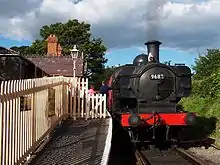 |
No. 9682 was withdrawn in 1965 and sent to Barry scrapyard. It was bought by the GWR Preservation Group in 1982 and, after overhaul, returned to traffic in 2000. It has since been loaned to various heritage railways, most recently the Chinnor and Princes Risborough Railway. It was taken out of service in 2009 and returned to Southall for overhaul.[135] | 1949 | Swindon Works | Dean Forest Railway |
Liveries
The GWR 5700 class locomotives have been in a number of liveries throughout preservation and their working lives.
| Livery | Image | Notes |
|---|---|---|
| GWR Shirtbutton | .jpg.webp) |
|
| GWR | .jpg.webp) |
|
| Great Western |  |
|
| GWR wartime black | .jpg.webp) |
|
| BR unlined black (early crest) | 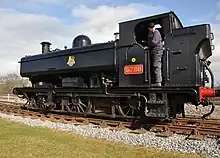 |
|
| BR unlined black (late crest) |  |
|
| BR lined black (early crest) | .jpg.webp) |
|
| London Transport | .jpg.webp) |
|
| Great North & South Railway | .jpg.webp) |
Repainted in a fictional livery for The Railway Children |
| National Coal Board | 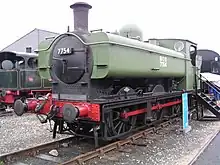 |
In fiction
No. 5775 on the Keighley and Worth Valley Railway featured in the film The Railway Children painted brown and lettered with GN&SR (Great Northern and Southern Railway).[136] In May 2014, No. 5775 was moved to National Railway Museum Shildon, for cosmetic restoration back to the livery used in the film.[117]
Duck the Great Western Engine in The Railway Series books by the Rev. W Awdry and the TV series Thomas the Tank Engine and Friends is a 5700 Class pannier tank. In the books, his number was No. 5741 (However, it was stated that his number was probably not his original).[137][138][139] The real 5741 was withdrawn on 30 June 1957 and scrapped on 31 May 1958.[140]
No. 5764 appeared several times in the 1976 BBC television adaptation of Charles Dickens' short ghost story, The Signal-Man.[114]
Model railways
Mainline Railways had OO gauge Class 5700 models in their catalogue in 1982–3, with models in GWR green and BR black.[141] Bachmann Branchline has made OO gauge models of the 5700 and 8750 classes in various GWR and BR liveries, and also in the liveries of LT, NCB, Stephenson Clarke, and even GNSR (the fictional railway company in The Railway Children).[142] Hornby produced various OO gauge models of the 8750 class in GWR and LT liveries.[143]
Graham Farish has made British N gauge models of the 5700 and 8750 classes in various GWR and BR liveries.[144] Dapol make British N gauge models of the 5700 and 8750 classes in various GWR and BR liveries.[145]
Just Like The Real Thing make an O gauge kit for the 5700 and 8750 classes.[146] Dapol since their merger with Lionheart Models in August 2016 [147] has produced several versions of the 57xx class and 87xx subclass in O gauge since 2018.[148] Minerva models has also released 0 gauge models of the 57xx in Great Western and British railway liveries.[149]
Aster Hobbies produced a gauge 1 live steam 5700 Pannier tank in several GWR liverys, BR black, BR green and London Transport. Although the LT shade of red is totally wrong, using signal red instead of the Crimson red, however it is still eye catching in the bright red.[150]
See also
- GWR 0-6-0PT – list of classes of GWR 0-6-0 pannier tank, including table of preserved locomotives
- LMS Fowler Class 3F – the London, Midland and Scottish Railway's standard shunter
- LNER Class J50 – the London and North Eastern Railway's standard shunter
- Hunslet Austerity 0-6-0ST – the War Department's standard shunter
- British Rail Class 08 – BR's standard shunter in the 1950s and 1960s
Notes
- Le Fleming mentions LNWR DX (943 built) and LMS Class 5 (842 built) among other numerous classes of British steam locomotives. However, he does not mention the WD Austerity 2-8-0 (935 built), possibly because all but three were transported to mainland Europe after D-Day for use by the British Army, and only 733 of the class later returned to mainline use in the UK.
- In 1950, the route classification was changed to Yellow because of the 5700s' low hammer blow.[24]
- Apart from the locomotives built specifically for shunting, the fitting of vacuum brakes, steam heating, and ATC became standard for the class, and was added to earlier locomotives within a few years of building. For locomotives build by outside contractors, the ATC equipment was added on arrival at Swindon.[2]
- The modified chimney was sometimes referred to as a 'Busby' or a 'bird cage'.[24][33]
- GWR had experimented with converting steam locomotives to oil burning in 1946–50 but the 5700s had not been included.[35]
- Reputedly, Collett had never heard of W. G. Bagnall before the use of contractors was considered.[36]
- GWR ordered a total of 306 locomotives from outside contractors between 1923 and 1938.[36]
- The 15 sheds were Abercynon, Aberystwyth, Bristol (Bath Road), Carmarthen, Croes Newydd, Didcot, Ferndale, Fishguard, Machynlleth, Oswestry, Radyr, Treherbert, Truro, Weymouth and Whitland.[24]
- Although British Rail had banned steam on its mainlines from August 1968, the 5700s bought by London Transport did sometimes travel on British Rail lines near Lillie Bridge.[71]
- During the raid, both men also extinguished fires from incendiary bombs. Frederick Blake was later quoted as saying "these blitzes seem tame to me" (in comparison to his experiences in World War I). His medals were sold in 2007.[75]
- Steam locomotives are now often seen on British mainline railways, but only as specials. Ferris[89] also mentions the WT Class 2-6-4Ts operated by Northern Ireland Railways as being amongst the last steam locomotives in regular use, but although withdrawn in 1971, they were last steamed in 1970.
- Moved to the railway in January 1970 and within a few months was used in filming for The Railway Children.[94]
- 7029 Clun Castle Ltd., a registered educational charity, owns the Tyseley Collection (held at Tyseley Locomotive Works). Vintage Trains, a charitable trust (previously known as Birmingham Railway Museum Trust), is the custodian of the Tyseley Collection.[95]
- Now based at the South Devon Railway.[96]
- Three 5700s were bought by the SVR Pannier Tank Fund: No. 5764,[89] No. 7714,[97] and No. 3612[79] which was bought for spares and not restored.
- The Quainton Railway Society now operates as the Buckinghamshire Railway Centre.
- No. 3650 is now owned by a group of GWS members, and was restored by a group of volunteers known as The Black Cupboard Gang.[109]
- Not to be confused with the Swindon Works. The Swindon Railway Workshop occupied part of the then closed Swindon Works. The business later moved to Lydney, Gloucester, and is now known as The Flour Mill.
- Quainton is the headquarters and workshop of the Buckinghamshire Railway Centre.
References
- Champ, Jim (2018). An Introduction to Great Western Locomotive Development. Barnsley: Pen & Sword Transport. p. 319. ISBN 978-1-4738-7784-9. OCLC 1029234106. OL 26953051M.
- le Fleming 1958, p. E78.
- Jones 2014, p. 21.
- Jones 2014, p. 39.
- le Fleming 1958, p. E12.
- le Fleming 1958, p. E4.
- Whitehurst 1973, pp. 7–13.
- le Fleming 1958, p. E7.
- Jones 2014, p. 12.
- Holcroft 1957, p. 82.
- Herring 2000, p. 122.
- Holcroft 1957, pp. 81–82.
- Chacksfield 2002, p. 24.
- Chacksfield 2002, p. 89.
- Holcroft 1957, pp. 127–8.
- le Fleming 1958, p. E10.
- le Fleming 1958, pp. E68, E69.
- Jones 2014, pp. 20–21.
- Chacksfield 2002, p. 87.
- Semmens 1985, p. 66.
- Whitehurst 1973, p. 146.
- Herring 2000, p. 123.
- le Fleming 1958, p. E77.
- le Fleming 1958, p. E79.
- le Fleming 1958, p. E80.
- Holcroft 1957, p. 147.
- Nock 1972, p. 115.
- Jones 2014, p. 36.
- Chacksfield 2002, p. 88.
- le Fleming 1958, p. E69.
- Whitehurst 1973, p. 155.
- Jones 2014, p. 43.
- Jones 2014, p. 44.
- Jones 2014, p. 46.
- Whitehurst 1973, p. 98.
- Atkins 1999, p. 37.
- Gibson 1984, p. 147.
- le Fleming 1958, pp. E79–E80.
- le Fleming 1958, pp. E77–E78.
- le Fleming 1958, pp. E80–E81.
- le Fleming 1958, pp. E77–E81.
- le Fleming 1958, p. E9.
- Jones 2014, pp. 140–144.
- Officer & Williamson 2012.
- Officer & Williamson 2014.
- Epping Ongar.
- Jones 2014, p. 151.
- Jones 2014, p. 167.
- Jones 2014, p. 165.
- Jones 2014, p. 169.
- Jones 2014, p. 149.
- Jones 2014, p. 150.
- Jones 2014, p. 186.
- Whitehurst 1973, pp. 32–34, 41–42, 51–52, 59–60, 67–68, 71–72, 74–76.
- Elliott 2012a.
- Elliott 2012b.
- Elliott 2012c.
- Bryan 1995, p. 147.
- Dare 2011.
- Elliott 2012d.
- Jones 2014, p. 86.
- Jones 2014, p. 10.
- le Fleming 1958, pp. E83–E84.
- Jones 2014, pp. 45–46.
- le Fleming 1958, p. E70.
- Jones 2014, p. 70.
- Jones 2014, p. 72.
- Jones 2014, p. 74.
- Jones 2014, pp. 76–77.
- Jones 2014, pp. 79–81.
- Scott-Morgan & Martin 2008, p. 64.
- Jones 2014, p. 82.
- Bryan 1995, p. 75.
- London Gazette (1941).
- Dix Noonan Webb.
- Earnshaw 1993, p. 35.
- Jones 2014, p. 68.
- Whitehurst 1973, pp. 82–83.
- Jones 2014, p. 140.
- Jones 2014, p. 145.
- Jones 2014, pp. 165–166.
- P & B Loco Group – 9629's History.
- Whitehurst 1973, p. 82.
- Whitehurst 1973, p. 83.
- Scott-Morgan & Martin 2008, p. 15.
- Scott-Morgan & Martin 2008, p. 16.
- Scott-Morgan & Martin 2008, p. 20.
- Jones 2014, p. 88.
- Ferris 1995, p. 23.
- Casserley 1979, p. 95.
- Jones 2014, p. 89.
- Jones 2014, p. 96.
- Scott-Morgan & Martin 2008, p. 145.
- Heavyside 1996, p. 7.
- Vintage Trains.
- Jones 2014, p. 156.
- Ferris 1995, p. 29.
- Jones 2014, p. 170.
- Jones 2014, p. 76.
- "Scrapyard Name: R.S. Hayes/Birds, Tremains Yard, Bridgend". Rail UK. Rail UK. Retrieved 4 December 2020.
- Jones 2014, p. 180.
- "9642". Preserved British Steam Locomotives. WordPress.com. 17 June 2017. Retrieved 4 December 2020.
- Derrick, Kevin (15 December 2016). Sixties Spotting Days Around London & The Home Counties. Stroud, Gloucestershire: Amberley Publishing. ISBN 9781445660646. Retrieved 4 December 2020.
- Vintage Trains 7752.
- South Devon Railway.
- Buckinghamshire Railway.
- Jones 2014, p. 142.
- Jones 2014, p. 139.
- Great Western Society 3650.
- 3650 - 57XX Class Didcot Railway Centre
- Great Western Society 3738.
- Jones 2014, pp. 144–145.
- Bodmin and Wenford.
- Jones 2014, p. 152.
- Severn Valley.
- Jones 2014, p. 153.
- Heritage Railway, p. 11.
- KWVR 5775.
- KWVR Railway Children Weekend.
- Jones 2014, pp. 155–6.
- "South Devon Railway - May 2023 Locomotive Roster".
- Jones 2014, p. 168.
- Jones 2014, pp. 169–70.
- Llangollen Railway.
- Jones 2014, p. 171.
- "7754 emerged in Transitional livery first for Llangollen". Heritage Railway. No. 311. October 2023. p. 23.
- Vintage Trains 7760.
- Jones 2014, p. 172.
- Jones 2014, p. 176.
- Vintage Trains 9600.
- P & B Loco Group.
- Jones 2014, pp. 181–183.
- Jones 2014, p. 183.
- Dean Forest Railway.
- Jones 2014, pp. 186–7.
- Jones 2014, p. 153–155.
- Jones 2014, p. 187–189.
- Wilbert Vere Awdry. The Island of Sodor - its People, History and Railways. p. 126.
- "Duck - Character Profile & Bio Thomas & Friends". Gullane (Thomas) Ltd. Archived from the original on 27 June 2017. Retrieved 27 June 2017.
- "Rail UK British Railway Steam Locomotive".
- "Mainline's big plans for 1983". Rail Enthusiast. EMAP National Publications. March 1983. pp. 36–7. ISSN 0262-561X. OCLC 49957965.
- Whalley 2013b, pp. 13, 18.
- Faulkner.
- Whalley 2013a, pp. 8–9.
- Dapol.
- JLTRT.
- "Lionheart & Dapol". Archived from the original on 11 April 2019. Retrieved 31 March 2022.
- "O gauge dapol locomotives".
- "Minerva reveals second '57XX' for 'O' | Hornby Magazine". Archived from the original on 7 November 2017. Retrieved 3 November 2017.
- "Aster Hobby Japan".
- "3650". Didcot Railway Centre – Home of the Great Western Society. 19 May 2012. Archived from the original on 11 October 2013. Retrieved 1 July 2014.
- "3738". Didcot Railway Centre – Home of the Great Western Society. 10 August 2013. Archived from the original on 26 September 2013. Retrieved 1 July 2014.
- "4612 – Steam Locomotive". Bodmin and Wenford Railway. Archived from the original on 12 February 2015. Retrieved 21 September 2014.
- "5700 Pannier Tank". Dapol Model Railway Company. Archived from the original on 12 February 2015. Retrieved 23 June 2014.
- "7754". Llangollen Railway Enthusiast and Archive Website 2014. Archived from the original on 19 June 2014. Retrieved 23 September 2014.
- "9629's History". The Pontypool & Blaenavon Locomotive Group. Archived from the original on 14 July 2014. Retrieved 23 September 2014.
- "9681 – Pannier Tank Engine". Dean Forest Railway. Archived from the original on 31 May 2014. Retrieved 23 September 2014.
- Atkins, Philip (1999). The Golden Age of Steam Locomotive Building (1 ed.). Penryn, Cornwall: Atlantic Transport Publishers and the National Railway Museum. ISBN 0-906899-87-7. OCLC 468585665.
- Bryan, Tim (1995). The Great Western at War 1939–1945 (1 ed.). Yeovil, Somerset, UK: Patrick Stephens. ISBN 1-85260-479-4. OCLC 60238810.
- Casserley, H. C. (1979). The last years of Metropolitan Steam (1 ed.). Truro, UK: D. Bradford Barton. ISBN 0-85153-327-2. OCLC 810550677.
- Chacksfield, John (2002). C.B Collett A Competent Successor (1 ed.). Usk, UK: The Oakwood Press. ISBN 0-85361-586-1. OCLC 51740457.
- Earnshaw, Alan (1993). Trains in Trouble: Vol. 8. Penryn: Atlantic Books. ISBN 0-906899-52-4.
- Dare, Kevin (2011). "3650's History". 3650. Archived from the original on 25 June 2013. Retrieved 14 February 2015.
- Elliott, Russ (2012a). "GWR 1906–1934 Loco Livery". GWR Modelling. Archived from the original on 6 October 2014. Retrieved 14 February 2015.
- Elliott, Russ (2012b). "GWR 1934–1942 Loco Livery". GWR Modelling. Archived from the original on 6 October 2014. Retrieved 14 February 2015.
- Elliott, Russ (2012c). "GWR 1906–1934 Loco Livery". GWR Modelling. Archived from the original on 6 October 2014. Retrieved 14 February 2015.
- Elliott, Russ (2012d). "BR(W) Steam Loco Livery 1948–64". GWR Modelling. Archived from the original on 6 October 2014. Retrieved 14 February 2015.
- "Exceptional Naval and Polar Awards". Dix Noonan Webb. December 2007. Archived from the original on 14 February 2015. Retrieved 14 February 2015.
- Faulkner, John. "Class 57XX". Hornby Railways Collector Guide. Archived from the original on 13 October 2011. Retrieved 14 February 2015.
- Ferris, Tom (1995). Severn Valley Locomotives as they were. Leicester, England: Midland Publishing. ISBN 1-85780-030-3. OCLC 33405136.
- Gibson, John (1984). Great Western Railway Locomotive Design – a Critical Appreciation (1 ed.). Newton Abbott, UK: David & Charles. ISBN 0-7153-8606-9. OCLC 12666432.
- "GWR 0-6-0PT Pannier Tank No. 5775". Keighley & Worth Valley Railway. Archived from the original on 17 February 2015. Retrieved 19 February 2015.
- "GWR 0-6-0PT 5786 (L.92)". South Devon Railway. Archived from the original on 15 December 2014. Retrieved 14 February 2015.
- "GWR 57XX Class 0-6-0PT No. 7715 (L.99)". Buckinghamshire Railway Centre. Archived from the original on 4 July 2014. Retrieved 14 February 2015.
- "GWR Pannier 7752 (LT No. L94)". Vintage Trains. Archived from the original on 29 December 2014. Retrieved 14 February 2015.
- "GWR Pannier 7760". Vintage Trains. Archived from the original on 29 December 2014. Retrieved 14 February 2015.
- "GWR Pannier 9600". Vintage Trains. Archived from the original on 29 December 2014. Retrieved 14 February 2015.
- "GWR Hall 4900 Class, Pitchford Hall No. 4953". Epping Ongar Railway. Archived from the original on 9 November 2014. Retrieved 14 February 2015.
- "GWR 5700/8750 Pannier tank O Gauge Model Loco kit". Just Like The Real Thing. Archived from the original on 12 April 2013. Retrieved 14 February 2015.
- Harris, Michael. Locomotives Illustrated no. 39 GWR pannier tanks post 1923.
- Heavyside, Tom (1996). Keighley & Worth Valley Locomotives as they were. Leicester, UK: Midland Publishing. ISBN 1-85780-050-8.
- Herring, Peter (2000). Classic British Steam Locomotives (1 ed.). Leicester, UK: Abbeydale Press. ISBN 1-86147-057-6. OCLC 44485041.
- Holcroft, Harold (1957). An Outline of Great Western Locomotive Practice 1837–1947 (1 ed.). London: Locomotive Publishing Company. OCLC 13299691.
- Jones, Robin (2014). Great Western Railway Pannier Tanks (1 ed.). Marlborough, UK: The Crowood Press. ISBN 978-1-84797-653-6. OCLC 859298680.
- le Fleming, H.M. (April 1958). Part 5: Six-coupled Tank Engines. The Locomotives of the Great Western Railway. Oxford: RCTS. ISBN 0-901115-35-5. OCLC 500544510.
- "Livery 'comeback' for The Railway Children Pannier". Heritage Railway. No. 190. Horncastle, Lincs, UK: Mortons Media. 5 June 2014.
- "No. 35053". The London Gazette (Supplement). 11 February 1941. p. 484.
- "Meet the Locomotives – Non-operational steam locomotives in storage or in course of restoration". Severn Valley Railway. Archived from the original on 2 July 2017. Retrieved 13 August 2017.
- Nock, O.S. (1972). The Great Western Railway in the 20th Century (2 ed.). London: Ian Allan. ISBN 9780711002272. OCLC 251662074.
- Officer, Lawrence H.; Williamson, Samuel H. (2012). "Explaining the Measures of Worth". MeasuringWorth. Retrieved 22 August 2014.
- Officer, Lawrence H.; Williamson, Samuel H. (2014). "Five Ways to Compute the Relative Value of a UK Pound Amount, 1270 to Present". MeasuringWorth. Retrieved 22 August 2014.
- "The Pontypool & Blaenavon Locomotive Group – 9629's History". 31 August 2012. Archived from the original on 14 July 2014. Retrieved 14 February 2015.
- "The Railway Children Weekend". Keighley & Worth Valley Railway. Archived from the original on 17 February 2015. Retrieved 19 February 2015.
- Russell, J. H. (1975). A pictorial Record of Great Western Engines.
- Scott-Morgan, John; Martin, Kirk (2008). Red Panniers: Last Steam on the Underground. Lydney, Gloucester: Lightmoor Press. ISBN 9781899889297. OCLC 271770628.
- Semmens, Peter (1985). History of the Great Western Railway 1. Consolidation, 1923–29. London: Allen & Unwin. ISBN 9780043851043. OCLC 59803211.
- "Vintage Trains – About Us – The Trust". 2 July 2013. Archived from the original on 29 July 2014. Retrieved 14 February 2015.
- Whalley, Tom (2013a). "Graham Farish by Bachmann Past and Present Models Rev. 11" (PDF). World of Model Railways. Bachmann Europe plc. GFPTW2013. Archived from the original (PDF) on 23 September 2015. Retrieved 23 June 2014.
- Whalley, Tom (2013b). "Bachmann Branchline Past and Present Models Rev. 5" (PDF). World of Model Railways. Bachmann Europe plc. BLPTW2013. Retrieved 23 June 2014.
- Whitehurst, Brian (1973). Great Western Engines, Names, Numbers, Types and Classes (1940 to Preservation). Oxford, UK: Oxford Publishing Company. ISBN 978-0-9028-8821-0. OCLC 815661.
Further reading
- Sixsmith, Ian; Derry, Richard (2011). The Pannier Papers No.2 The 57XX Engines 36XX, 37XX, 46XX. Bedford, UK: The Irwell Press. ISBN 978-1-906919-33-7. OCLC 755069689.
- Sixsmith, Ian; Derry, Richard (2011). The Pannier Papers No.3 The 57XX Engines 57XX, 67XX, 77XX. Bedford, UK: The Irwell Press. ISBN 978-1-906919-44-3. OCLC 779581588.
- Sixsmith, Ian; Derry, Richard (2012). The Pannier Papers No.4 The 57XX Engines 87XX, 96XX, 97XX. Bedford, UK: The Irwell Press. ISBN 978-1-906919-48-1. OCLC 867995656.
External links
- 5700 Tank Class Introduction
- Guide to GWR Pannier Tank Classes
- Steam Locos in Profile – The GWR 5700 Pannier Tanks – a 15-minute YouTube documentary
- No. 3650 in action at Didcot Railway - includes footage taken in the cab and of the motion (7 minutes)